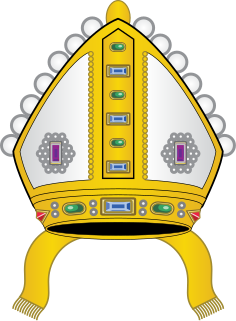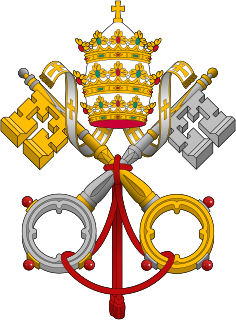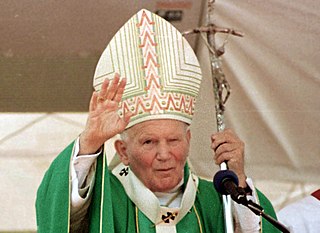Related Research Articles
Plainsong is a body of chants used in the liturgies of the Western Church. Though the Catholic Church and the Eastern Orthodox churches did not split until long after the origin of plainsong, Byzantine chants are generally not classified as plainsong.

The Tridentine Mass, also known as the Traditional Latin Mass or Usus Antiquior, is the Roman Rite Mass of the Catholic Church. It appears in typical editions of the Roman Missal published from 1570 to 1962. Celebrated exclusively in Ecclesiastical Latin, it was the most widely used Eucharistic liturgy in the world from its issuance in 1570 until the introduction of the Mass of Paul VI.

The papal tiara is a crown that was worn by popes of the Catholic Church from as early as the 8th century to the mid-20th. It was last used by Pope Paul VI in 1963 and only at the beginning of his reign.

A papal coronation was the ceremony of the placing of the papal tiara on a newly elected pope. The first recorded papal coronation was that of Nicholas I in 858. The last was the 1963 coronation of Paul VI, who soon afterwards abandoned the practice of wearing the tiara. None of his successors have used the tiara, and their papal inauguration celebrations have included no coronation ceremony.

Traditionalist Catholicism is a set of religious beliefs and practices comprising customs, traditions, liturgical forms, public and private, individual and collective devotions, and presentations of Catholic Church teachings that were in vogue in the decades that immediately preceded the Second Vatican Council (1962–65). It is associated in particular with attachment to the 1570–1970 form of the Roman Rite Mass, which traditionalist Catholics call the Traditional Latin Mass or TLM or the Extraordinary Form of the Mass.

The mitre or miter, is a type of headgear now known as the traditional, ceremonial headdress of bishops and certain abbots in traditional Christianity. Mitres are worn in the Catholic Church, Orthodox Church, as well as in the Anglican Communion, some Lutheran churches, and also by bishops and certain other clergy in the Eastern Catholic Churches and the Oriental Orthodox Churches. The Metropolitan of the Malankara Mar Thoma Syrian Church also wears a mitre during important ceremonies such as the Episcopal Consecration.

A Papal Mass is the Solemn Pontifical High Mass celebrated by the Pope. It is celebrated on such occasions as a papal coronation, an ex cathedra pronouncement, the canonization of a saint, on Easter or Christmas or other major feast days.

Papal regalia and insignia are the official items of attire and decoration proper to the Pope in his capacity as the head of the Roman Catholic Church and sovereign of the Vatican City State.

The Ring of the Fisherman, also known as the Piscatory Ring, is an official part of the regalia worn by the Pope, who is head of the Catholic Church and successor of Saint Peter who was a fisherman by trade. It used to feature a bas-relief of Peter fishing from a boat, a symbolism derived from the tradition that the apostles were "fishers of men". The Fisherman's Ring is a signet used until 1842 to seal official documents signed by the Pope. Since at least the middle ages it has been a tradition for Catholics meeting the Pope to show their devotion by kissing the ring.

Papal inauguration is a liturgical service of the Catholic Church within Mass celebrated in the Roman Rite but with elements of Byzantine Rite for the ecclesiastical investiture of a pope. Since the inauguration of Pope John Paul I, it has not included the 820-year-old (1143–1963) papal coronation ceremony.
Indult Catholic was a traditionalist Catholic loaded term used from the early 21st century until 2007 as a pejorative label applied to Catholics who attended only the licit celebrations of the Tridentine Mass in Latin according to the 1962 edition of the Roman Missal and regulated by the local bishop through an indult that conformed to the 1984 Congregation for Divine Worship and the Discipline of the Sacraments norms in the ecclesiastical letter Quattuor abhinc annos.
Quattuor abhinc annos is the incipit of a letter that the Congregation for Divine Worship and the Discipline of the Sacraments sent on 3 October 1984 to presidents of episcopal conferences concerning celebration of Mass in the Tridentine form.
The Pontifical Commission Ecclesia Dei was a commission of the Catholic Church established by Pope John Paul II's motu proprioEcclesia Dei of 2 July 1988 for the care of those former followers of Archbishop Marcel Lefebvre who broke with him as a result of his consecration of four priests of his Society of St. Pius X as bishops on 30 June 1988, an act that the Holy See deemed illicit and a schismatic act. It was also tasked with trying to return to full communion with the Holy See those traditionalist Catholics who are in a state of separation, of whom the Society of Saint Pius X (SSPX) is foremost, and of helping to satisfy just aspirations of people unconnected with these groups who want to keep alive the pre-1970 Roman Rite liturgy.

The Napoleon Tiara was a papal tiara given to Pope Pius VII in June 1805 a few months after he presided at the coronation of Napoleon I and Joséphine de Beauharnais. While lavishly decorated with jewels, it was deliberately too small and heavy to be worn and meant as an insult to the pope.[citation needed] In the painting of The Coronation of Napoleon by Jacques-Louis David, the tiara is held behind the pope by one of his aides.
Universal indult is a term that was used primarily by traditionalist Catholics in a very specific sense. Since an indult signifies a favour granted to an individual or limited group, a similar measure applied to every member of a particular class of persons would in reality be a change of the law, not an indult. However, in spite of its self-contradictory character, traditionalist Catholics used the term "universal indult" to refer to a general permission that they hoped the Pope would grant to all Catholic priests who celebrate Mass in the Roman Rite to do so in its Tridentine Mass form even publicly without first obtaining a specific indult or permission. Groups such as the Priestly Fraternity of St. Peter have standing specific indults to say the Tridentine Mass.
Summorum Pontificum is an apostolic letter of Pope Benedict XVI, issued in July 2007, which specifies the circumstances in which priests of the Latin Church may celebrate Mass according to what he calls the "Missal promulgated by Blessed John XXIII in 1962", and administer most of the sacraments in the form used before the liturgical reforms that followed the Second Vatican Council.

The ceremonial of Benedict XVI (2005-2013) re-introduced several papal garments which had previously fallen into disuse.
The Code of Rubrics is a three-part liturgical document promulgated in 1960 under Pope John XXIII, which in the form of a legal code indicated the liturgical and sacramental law governing the celebration of the Roman Rite Mass and Divine Office.

The papal ferula is the pastoral staff used in the Catholic Church by the pope. It is a rod with a knob on top surmounted by a cross. It differs from a crosier, the staff carried by other bishops of Latin-rite churches, which is curved or bent at the top in the style of a shepherd's crook.